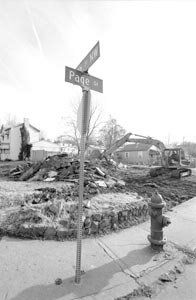Earth craft: The greening of 10th & Page
Driving down 10th Street, you may have noticed the new technicolor homes at the intersection of Page Street. They're covered in pumpkin, periwinkle, cranberry, and canary siding. But they're actually all pretty green.
Piedmont Housing Alliance is sponsoring 13 new units for the 10th and Page neighborhood with a projected completion date of December 31. These homes constitute part of the Virginia pilot program for EarthCraft, a set of sustainability standards created by an Atlanta-based non-profit institute.
The goals include maximum energy efficiency and a minimal environmental footprint. With each EarthCraft-certified house estimated to save as much in hydrocarbon (CO2) emissions as removing one car from the streets, the Alliance has adopted EarthCraft at 20 other homes around town.
Among other features, these EarthCraft houses use blown-in cellulose insulation, helping to ensure very little heat or cooling loss. For the exterior, the Alliance is using only HardiPlank. Like vinyl, it is a long-term wood substitute that won't rot and is easy to maintain. But, unlike vinyl, HardiPlank is recycled material that's less polluting in its manufacture.
One house– at 214 10th Street NW– even features bamboo flooring that is just as hard as traditional oak or pine. In addition, bamboo renews itself faster in the environment than wood.
While the greening of 10th and Page is a victory for the environmentally conscious, a comparable victory for the Alliance is the creation of an outpost of home ownership in a neighborhood that has suffered too long from absentee landlords and rental turnover.
Some residents have complained that Charlottesville's housing market is so stratified. In an attempt to bridge the gap, 10th and Page may reintroduce the idea of a "middle" to Charlottesville.
"The people who are low income are being left behind, and the population that needs affordable housing is growing," says Mark Watson, the Alliance's director of project development.
Instead of reinforcing that perverse term "rental opportunities," the Alliance is trying to encourage first-time home-ownership at 10th and Page in an economically viable way.
The Page Street Initiative includes homes that will range from 1,198 square feet to 1,770 square feet to meet the needs of Watson's target market: low- to moderate-income families. "We've had lots of interest– probably 30 to 40 calls per week," Watson says.
Most of these three-bedroom, 2.5-bath houses range from $219,000 to $339,000. Keeping in mind that the median home price in the Charlottesville area is $247,250, first-time home-owners could do a lot worse than getting a new "green" house for the price of a fixer-upper.
The one obvious danger in all of this is gentrification. Rescuing a waning neighborhood and keeping house prices relatively low is a recipe for speculation. If wealthy opportunists push up prices, the diversity that once gave the neighborhood its vitality is compromised, and we may as well be playing a game of shuffleboard. Ideally, the goal for the Page Street Initiative should be the retention of its current residents and whatever neighborhood fabric has developed in spite of its rate of rental turnover.
The idea should be to reconstitute Page Street, not replace it.
However, the greening of 10th and Page is an inherently good thing. The completion of the Alliance's Page Street Initiative follows closely on the heels of the "Urban Habitats" design competition which is bringing new life to the Sunrise Trailer Court in lower Belmont.
Both Sunrise and 10th and Page show signs of an urban conscience, and are quickly becoming very promising developments in Charlottesville.

September 2003: backhoes clear the site
FILE PHOTO BY JEN FARIELLO

August 2005: New houses replace the blight
PHOTO BY WILLIAM RICHARDS